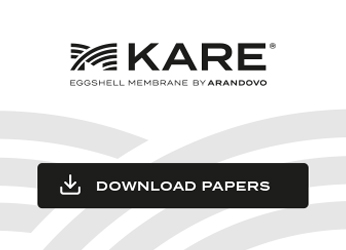Our beloved canine companions often surprise us with their vitality and energy. However, sometimes they may face health problems that affect their well-being and quality of life. One of these problems is called muscular atrophy.
In this blog post by Arandovo, the company that develops MKARE’s 100% natural functional ingredient, we will explore in detail what is muscle atrophy in animals, the possible causes behind this disorder, the symptoms we should be on the lookout for and the treatments available to help our furry friends regain their strength and vitality.
What is muscle atrophy in animals?
Muscle atrophy in animals is a process involving a decrease in the size and strength of an organism’s muscles. This phenomenon is characterized by a reduction in muscle mass, often resulting in a loss of function and weakness in the affected area.
As in humans, muscle atrophy in animals can manifest from a variety of underlying causes and conditions, and can affect both domestic pets and wild animals.
In simple terms, muscle atrophy in animals refers to the deterioration of muscle tissue. Muscles are responsible for facilitating movement, maintaining posture and performing many essential functions in the body. When muscles are not used properly or are affected by factors such as injuries, diseases or nutritional imbalances, they can begin to lose their strength and size.
In pets such as dogs, muscle atrophy can be of particular concern as it can affect their quality of life, mobility and ability to carry out daily activities. Therefore, it is very important to know the causes, symptoms and treatments in order to offer them the best possible care.
Causes of muscle atrophy in dogs
The causes of muscle atrophy in dogs may differ and be the result of various conditions. Some of the most common causes include:
Lack of muscle use
Similar to humans, if a dog does not regularly use its muscles due to inactivity or prolonged rest due to injury, they can begin to weaken.
Neuromuscular diseases
Neuromuscular disorders such as myasthenia gravis and polyradiculoneuritis can affect communication between nerves and muscles, leading to muscle atrophy.
Chronic diseases
Chronic diseases such as arthritis and dysplasia can limit a dog’s mobility and cause muscle breakdown due to lack of activity.
Nerve injuries
Nerve injuries, whether from trauma or diseases, can disrupt normal muscle function and result in atrophy.
Nutritional problems
A deficient diet in essential nutrients such as protein, vitamins and minerals, can negatively affect muscle growth and function.

Common symptoms of muscle atrophy in dogs
Detecting muscle atrophy in its early stages is essential to start effective treatment that can improve the animal’s health as much as possible. Some common symptoms that could indicate the presence of this condition include:
Muscle mass loss
Noticing that your dog’s body appears thinner and less muscular than usual can be an obvious sign.
General weakness
Dogs with muscle atrophy may show decreased physical strength and endurance, which could manifest as difficulty climbing stairs or performing activities that were once easy.
Posture and gait changes
A stooped posture or unusual gait may indicate muscle problems.
Difficulty in getting up
If your dog tries to stand up after resting but struggles, it could be a sign of muscle atrophy in the hind legs.
Changes in behavior
Affected dogs may become less active and avoid activities they once enjoyed, such as running or playing ball.
Best treatments to cure muscle atrophy in dogs
The good news is that there are several treatments available to treat and help dogs with muscle atrophy regain their strength and vitality. It is important to remember that the appropriate treatment will depend on several factors and the severity of the condition. Some of the most effective treatments include:
Physical therapy and controlled exercise
A vet may recommend specific exercises and physical therapy to gradually strengthen the affected muscles and improve the dog’s mobility.
Proper nutrition
A balanced, rich in protein, vitamins and minerals diet is essential to promote muscle recovery.
Nutritional supplements
In some cases, the vet may suggest natural animal food supplements to support muscle health, such as omega-3 fatty acids and amino acids.
Medical treatment
If muscle atrophy is the result of an underlying disease, specific treatment for that disease may help stop its progression.
Medicines
In certain cases, medication may be prescribed to improve muscle function and ease symptoms. Specialists must always be consulted.
Emotional support and care
Providing a supportive and loving environment for your dog during their recovery is critical to the overall well-being.
As you have seen, muscle atrophy in dogs is a legitimate concern for any pet owner, but with proper care and timely medical attention, it is possible to help our four-legged friends overcome this condition. It is always advisable to consult a veterinarian should any sign of muscle weakness or change in your dog’s behavior arise.
MKARE to improve the health of your dog
Prevention plays a crucial role in the long-term muscle health of our furry friends. Maintaining an active and healthy lifestyle, providing a balanced diet and making sure they receive regular medical care are important steps to reduce the risk of developing muscle atrophy.
In addition, research and veterinary medicine continue to advance, opening up new possibilities in the treatment and management of muscle atrophy in dogs. Innovative therapies, such as gene therapy and technology-assisted rehabilitation, are emerging as promising options to help dogs regain lost muscle function.
Food supplements, as we have discussed above, can also make the health and quality of life of our four-legged friends improve on a daily basis.
In this case, Arandovo has developed MKARE, a 100% natural supplement based on the inner membrane of the egg which is rich in collagen (I, V and X), hyaluronic acid, elastin, chondroitin sulfate, glucosamine and over 500 proteins.
Furthermore, thanks to the biomolecules in the egg membrane such as collagen, elastin and various GAGs like hyaluronic acid, chondroitin and heparan sulfate, the bone regenerating effect is produced.
Thanks to this 100% functional and natural ingredient, we provide pets with the necessary energy to maintain and improve their quality of life.
Although muscle atrophy can be challenging, it is not insurmountable. With a commitment to provide the necessary care and appropriate medical attention, we can help our dogs return to enjoying an active and joyful life.
In addition, with early detection and proper treatment, it is possible to reverse or at least slow down its progression.
Each small step toward recovery is a testament to the strong connection we share with our canine companions, and together, we can overcome any obstacles on the road to their lasting well-being.
If you want to know how MKARE can help your pets, check our website now or get in touch us, we will help you in everything we can.




